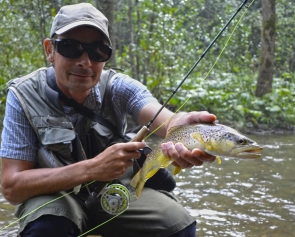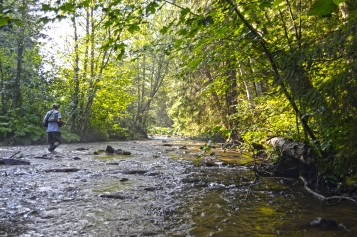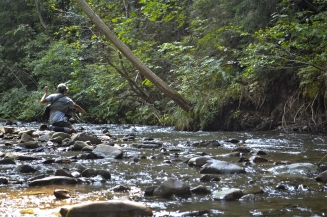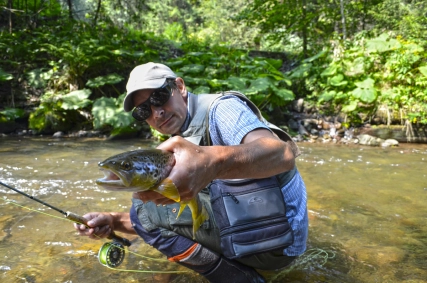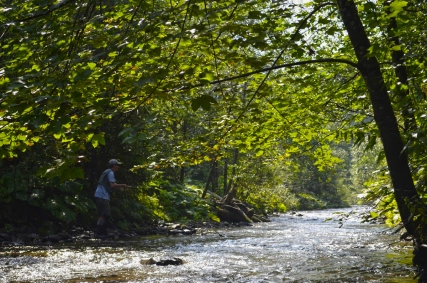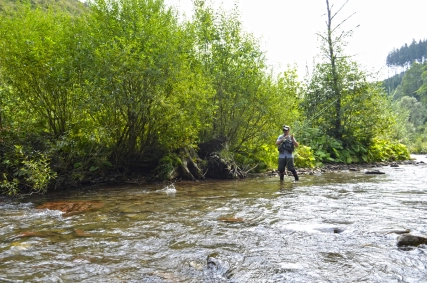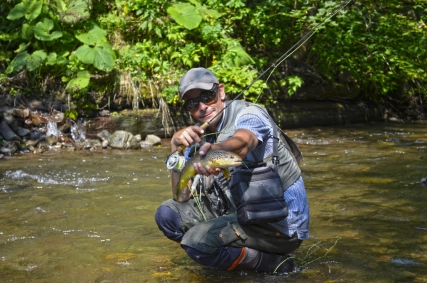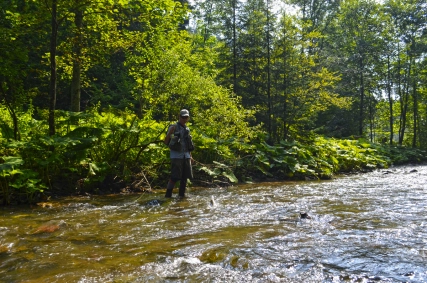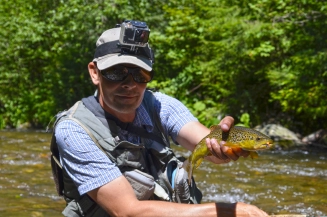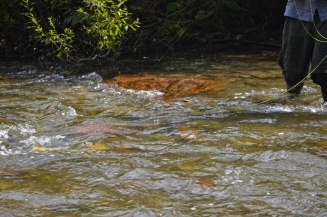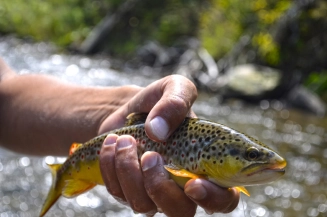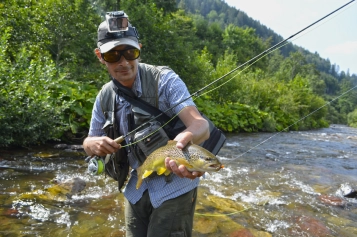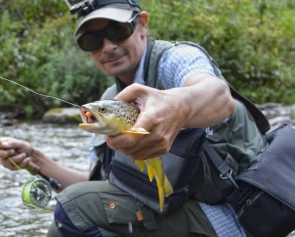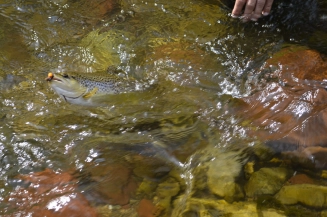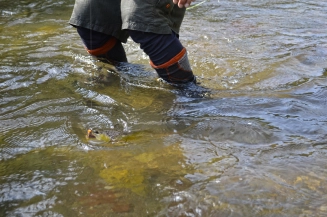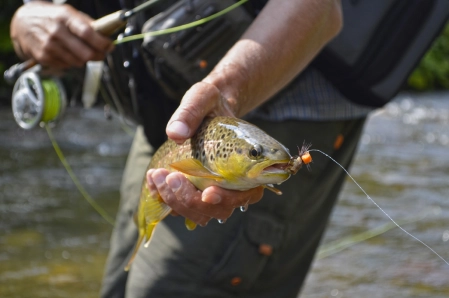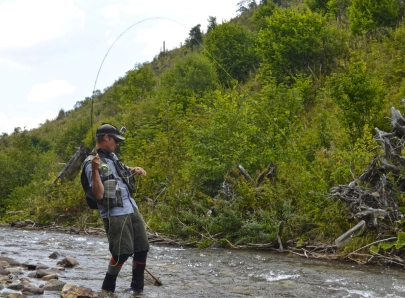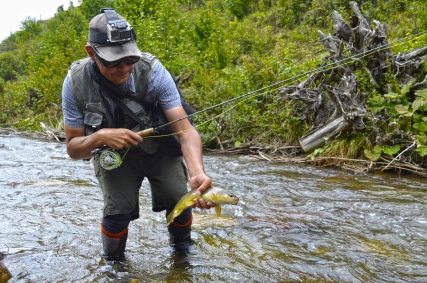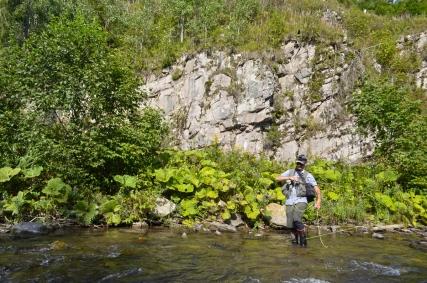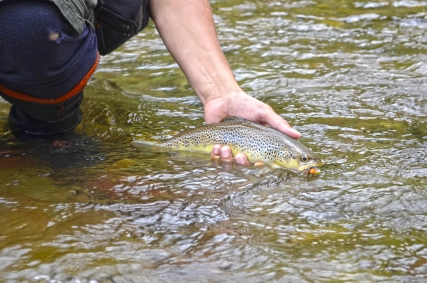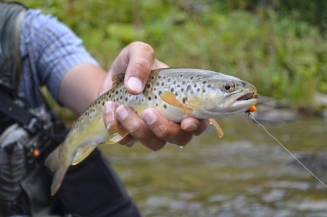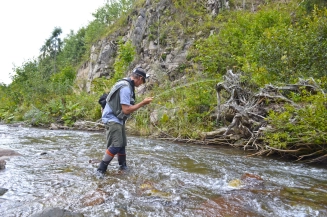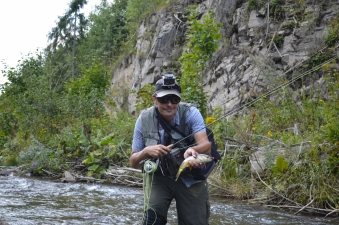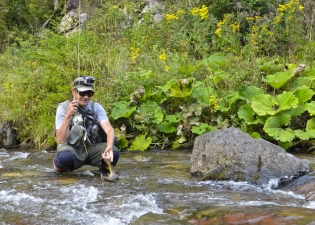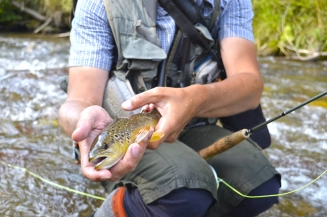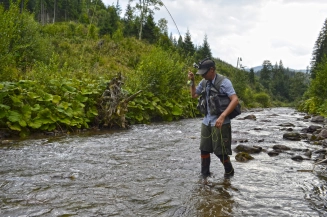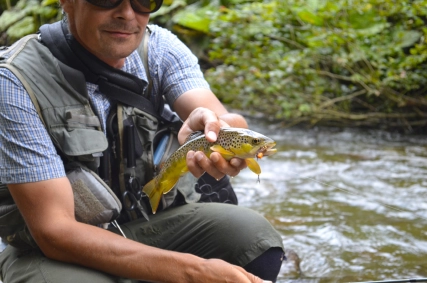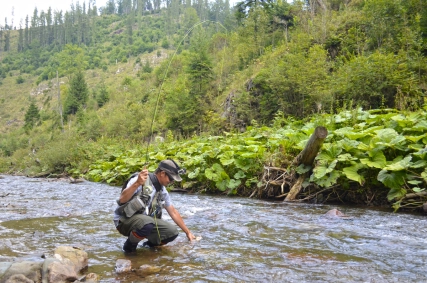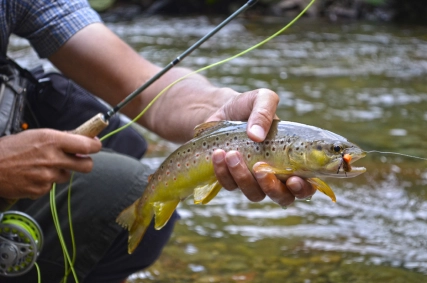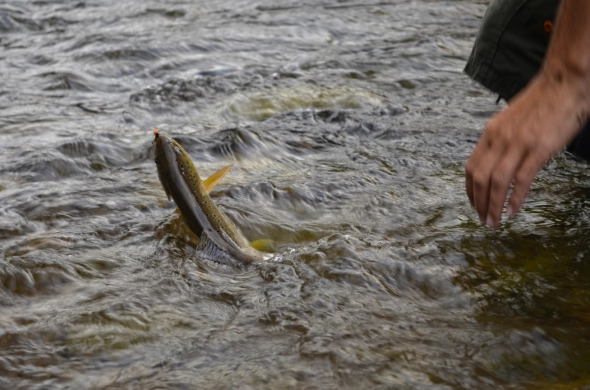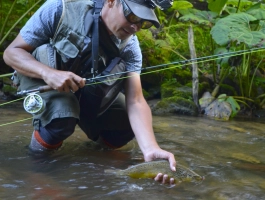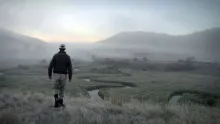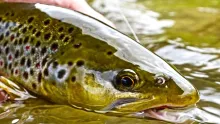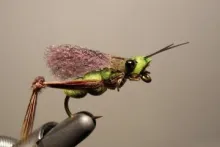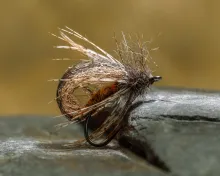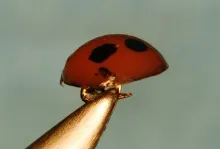Fly fishing with terrestrials in Slovakia at its best.
It was the last week of August, when I received a call from a good friend of mine, who happens to be the same person with whom I experienced one of my best days of fly fishing two years ago. I made report about this trip called Perfect day published here.
The reason
why he called me was the ichthyological research on one of his rivers to find out how many fish it holds, and how their living conditions are.
He asked me if I would be interested in replacing the usual method of electric fishing (e-fishing) with my fly-fishing skills. According to his opinion is the efficiency of my fly-fishing technique on small mountain rivers would be higher than that of e-fishing.
Also, the treatment of the fish would be gentler, not stunning or harming the fish. I was pleased to hear such a positive statement about my fly-fishing skills, but I tried to escape my increasing pride by wittily proposing him to nickname me an electric fishing device, which immediately caused him to burst into laughter.
This small mountain river
I am writing about is highly protected by Slovak Nature reservation law, and is managed by the Slovak State forestry. My friend is the fishery technician of this institution, and responsible for all its rivers and on his behalf, I was allowed to fish on this unique piece of water.
The river has been closed
for public access for the last few decades, and there has been no fish stocking activities for at least the same amount of time. Knowing that I was going to be fishing a totally untouched mountain river made me even more excited.
On the other hand, parts of the river surroundings in form of forests were heavily changed by storms a couple years ago and must have been cleaned. This was the actual subject of our research: How was the this river influenced by the forestry management cleaning work?
Inspired by all of this information I started to consider the following: would it be possible to come close to the perfect fly-fishing day experience two years ago – or even to top it?
The summer was
at its peak and air temperatures were often reaching the 30 degrees Celsius mark, which often caused the rain storms in mountains. It happened two days before our fly-fishing trip. The only luck was that these high mountain rivers, even when flooded, can quickly get rid of the water. Nonetheless I had to make the decision knowing that such an occasion doesn't come along every day. So, I agreed, and the fly-fishing adventure was ready to start.
Since I prefer
exactly this kind of river – small high mountain rivers – it didn't take so long to pick, prepare and pack all necessary fly-fishing equipment I needed. A 6 foot 6 rod, a light reel, a floating fly-line and my fly-boxes were packed in just few minutes along with it my camera and a small action camera for documentation.
Nevertheless, I still had feeling of missing something important.
Oh yes, my fly-box with terrestrial patterns, especially grasshoppers, which typically produced a lot of success during hot summer days, wasn't yet in my fishing vest pocket. Should the weather forecast be true, and should we be blessed with few hours of sunshine on the mentioned day, then these terrestrial patterns are more than important.
How right this intuition was, will become apparent later in this report.
We agreed to meet
at 8:00 am. Arriving on time – punctuality should be every fisherman’s virtue: never be late for church, work or fishing – we had to make one last decision, namely to pick the stretch, which we would fish on this 16 km long river. We decided to check and research a part of the river where the banks were partly untouched and partly harmed from the above mentioned storm. After approximately 40 minutes of driving we finally got there.
The river is hidden
in a deep valley, covered with thick vegetation on both sides, and was greeting us with the last bits of fog, which was hovering over the already dropped water, slowly disappearing with as the sun took over. We quickly prepared for a whole day of fly fishing, changed clothes and the adventure was ready to begin.
The air temperature was about 16 °C and the water not more than 10 °C. The water level was good again, in spite of the heavy rain two days ago. After having checked the river's insect fauna, I decided to fish my favorite fly patterns, namely a small dun larva imitation on a size 16 hook and a size 18 micro nymph, fished together with small spider-fly as strike indicator.
The riverbed was mostly shallow with rapids and a lot of obstacles in the form of stones, boulders and trees. The tactic was first to find out where the fish had their favorite feeding and hiding spots.
So, I carefully fished all potential upstream fish spots. Casting and presentation was very demanding. Especially because of all the obstacles and snags they caused, and because the best fish hiding spots were always blocked.
The best solution
under such conditions was to cast my flies as close as possible to the obstacles, and at the same time not too close, to avoid snags in tree roots, trunks and the like. The weight of the nymphs in the shallow rapids was also very important.
On one side, they shouldn't be too light, to be visible to fish and on other side not too heavy, because of the shallow water.
Noteworthy was also a lot of "fly-saving tree climbing", which occurred mostly when I did not pay attention to what was behind or over me. This caused some funny situations. I was able to document one of these incidents in the video part of this report.
The difficulties
eventually paid off. Just after a few successful casts, the strike indicator disappeared under the surface. I set the hook just right, and the first fish was on. My first fish from this untouched river jewel was a beautiful, wild approximately 40 cm big brown trout, with surprising strength. Fighting had to be done very carefully and with great patience.
One small mistake and the brown trout would've been off, because of so many obstacles. My friend documented the first fish, took photos and after he finished his obligations, I released this brown trout unharmed back to his habitat.
Another cast
and the spider fly went down again. A second brown trout was interested in my nymphs. This time the trout was even bigger and stronger than the first one. This nice fish was also documented, photographed and of course released.
This procedure continued while I fished the river part with surrounding not directly influenced by the storm.
All in all, I caught and landed more than 50 brown trout in sizes between 10 and 45 cm on a river stretch not longer than 300 meters.
All of them were naturally reproduced fish, wild, healthy, strong fighters and with unique beautiful spot patterns. Even more were able to escape from my hook or got spooked and I was only able to observe them swimming away through my Polaroid glasses.
My friend and me were both very surprised at the quantity and quality of fish, knowing that these brown trout were all totally natural fish.
By now,
most of you will most likely be asking yourself "What does all this have to do with the title of this report?". A fair question, which will be answered in the following lines.
Andrej Polcic
As we were
getting closer to the river stretch where the density of bank vegetation began to shrink, I could see a lot of nice trout swimming very close to the bank in the shallow holes with slow rapids – and of course with plenty of trees fallen in.
Their feeding behavior
was different as well. The first tow hours of fishing had produced takes almost exclusively underwater on my small nymphs.
With more and more sunshine reaching into the deep valley, the trout started to attack the dry fly intended as strike indicator. Since I still had the other two flies on my leader, the casting and presentation to those difficult spots became more than challenging.
After spooking countless nice brownies while we were wading upstream in the river because of the heavily vegetated river banks, we came to one valley, which had almost no trees surrounding it.
A straight, shallow river bed, no bends and no deep pools. Added to this, plenty tree remains in the water caused by the forestry maintenance.
I would like to thank you for your reading patience
This is where
the actual story of this report starts, and at this point I would like to thank you for your reading patience.
I would bet that upon first sight most of fly fisherman, for good reasons, would just avoid such a river stretch and walk by. My friend's opinion wasn't much different. He is a learned and experienced fishery technician. He reckoned that it wouldn't make any sense to fish this barren river stretch.
I had the opposite opinion.
My deciding reason for wanting to give it a chance was the loud symphony by countless grasshoppers inhabiting this special valley. Thanks to the missing trees and their shadows, there was just enough sunshine coming into the valley to enable grasshoppers to prosper very well here. Plenty of different flowers and fallen trees made this area a perfect grasshopper environment.
During lunch time
I was persuading my friend to try this grasshopper valley. After considering my reasons he agreed. But he had one condition: shouldn't we catch any fish in the upcoming 10 minutes, then we would pass by this valley. I agreed as well.
But how should
I efficiently fish such complicated river spots, when I already had some big issues with presenting my flies as natural as possible?
Thank God, I had my grasshopper flies with me. Just one large dry fly tied on a short leader would help me to master casting under such conditions. Moreover, it is typical for grasshopper fly fishing to present the fly aggressively.
The big size of the hopper imitations, typically a hook size 10, and their great floatability, I tie my grasshoppers using foam materials, made them perfect for river stretches like this.
All I needed to find out, was if this grasshopper valley hosted some trout, and if so, would they be interested in my hopper?
One more real grasshopper examination and a comparison to my imitations, and the choice was made. A brown foam hopper with reflective indicator on its back for better visibility became the guinea pig.
Tied on a short leader I cast the grasshopper in eager anticipation on the river surface of this mysterious valley, and my hopper was aggressively attacked just after a few seconds by a beautiful wild brow trout. Not once, but twice did this hungry fish bite my fly.
Me and my friend were amazed at this feeding behavior. The condition for one fish within 10 minutes was met, so I could try my luck on other spots in this grasshopper valley.
As by a miracle
brown trout were almost everywhere, and they loved my hopper pattern! I caught trout close to the banks, in the middle of the river, behind stones, in front of stones, beside stones, in shallow water, in deeper water, in rapids, in calm waters, between sunk tree branches and in tree roots.
Just about every cast produced a take.
Some brown trouts were even following and swimming after the hopper for couple of meters. I have never experienced such a feeding spectacle using one terrestrial dry fly – and all on this river stretch, which would be avoided by most of fishermen.
One single grasshopper
pattern brought me more than 70 landed and at least twice as many lost brown trout over a stretch of approximately 300, which is my personal best with just one dry fly.
I must also mention that the feeding activity could have been even better. The reason for my assumption is the sun, which because of many clouds, was not able to warm the river to its optimal temperature, which makes the fish' feeding activity on high mountain rivers even more intense.
When we finished our grasshopper valley fishing adventure, we wanted to try one more part of the river, which wasn't influenced by the storm nor by forestry maintenance before the oncoming darkness. On this river stretch with strong bank vegetation, the grasshopper fly also worked very well.
Overall our ichthyological research
on this special River was very successful.
127 brown trout in great condition were landed and documented.
The storm and following forestry maintenance did indeed change the river surroundings, but they also played an important role in contributing to form a perfect habitat for terrestrial insects, especially grasshoppers, which again caused this, at first sight, barren river stretch to be inhabited by countless beautiful brown trout.
127 brown trout
It might sound like paradox, but if it was not for devastation of the river surroundings by the storm, I wouldn't be able to catch so many outstanding wild brown trout in the grasshopper valley.
I was very happy and thankful, that I once again could explore new unique piece of water in my homeland Slovakia, and I look forward to the next ichthyological explorations of many more Slovakian river treasures with my friend.
Should you be interested in fly fishing in Slovakia, you are more than welcome to visit my webpage: www.flyfishing-slovakia.com
Andrej Polcic
- Log in to post comments

